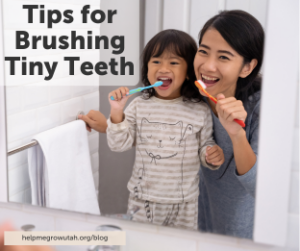 It is such a heartwarming feeling to see that first little tooth peek through your child’s gummy smile! But as those teeth begin to grow, how can we make sure they develop into healthy teeth that will last a lifetime?
It is such a heartwarming feeling to see that first little tooth peek through your child’s gummy smile! But as those teeth begin to grow, how can we make sure they develop into healthy teeth that will last a lifetime?
Starting early with healthy brushing practices isn’t just about stopping cavities, it’s about creating an environment that will result in a confident and happy smile for years to come. Below, we will cover the importance of taking care of those little teeth, brushing guidelines for the early years, and some fun ideas for cultivating positivity in brushing experiences that may result in something your child could even look forward to!
Importance of Healthy Brushing Habits
- Oral Health: Regular brushing helps prevent cavities and gum disease, laying the foundation for a lifetime of good oral health.
- Cost Savings: By maintaining good dental hygiene, families can avoid costly dental procedures and treatments.
- Growth and Development: Healthy teeth are essential for proper chewing and speaking. They help with nutrition and can boost a child’s confidence.
- Pain Prevention: Good oral hygiene can reduce the risk of tooth decay, which can lead to pain and discomfort in your little one.
Brushing Guidelines
The American Academy of Pediatrics recommends the following brushing guidelines from 0-6 years of age.
- Cleaning Gums: Even before teeth appear (usually around 6-10 months), it’s important to clean your baby’s gums. Use a clean, damp washcloth to wipe their gums twice a day, especially after night feedings. This helps establish a routine and promotes oral health from the start.
- 0-3 Years: Once teeth emerge, use a smear of fluoride toothpaste (about the size of a grain of rice) with a soft-bristled baby toothbrush. Brush all sides of the teeth twice a day: once in the morning and once before bedtime.
- At this stage, it’s common for babies to swallow small amounts of toothpaste. Choose a fluoride toothpaste specifically designed for young children with a safe swallowing formula. These products are made to minimize the risk of excess fluoride ingestion while still providing protection against cavities.
- 3-6 Years: Add a pea-sized amount of fluoride toothpaste to brushing routine. At this age, children often want to brush their own teeth, but they still need help. Parents should assist with brushing until children develop the necessary motor skills, typically around 7-8 years old.
- At this age, some children may still swallow toothpaste, so it’s important to use a fluoride toothpaste labeled as safe to swallow in small amounts. Many children’s toothpastes are formulated with lower fluoride concentrations to reduce the risk of fluorosis (a condition caused by excessive fluoride intake during tooth development). Always check the label to ensure the toothpaste is suitable for your child’s age group.
- You can learn more about the commonly asked questions about fluoride here, but we recommend speaking to your dentist about specific concerns and questions you may have for your child.
Typically, being consistent in timing with brushing can make it feel like a normal part of the day for your child. Examples of when to do this could be after meals or before their bedtime. While establishing this routine, you can explain the importance of brushing and use age-appropriate language that they can understand. One of my favorites I’ve heard is that brushing can prevent “sugar bugs” (cavities).
The environment you create to establish these routines can make a big difference as well! Hold your child in a comfortable position where they can see, and over time allow them to take turns brushing. This can give them a sense of control while also ensuring their teeth get clean. Teaching this skill to your little one can be hard at times, so work on remaining patient and calm if your child resists. Try again at a later time if they continue to resist, rather than forcing it.
Getting children to allow parents to help with brushing their teeth can sometimes be a challenge, but there are several strategies that can make it easier and more enjoyable.
Make It Fun!
- Songs and Rhymes: Sing a fun song or use a timer with a catchy tune to make brushing feel like a game. Sesame Street created a fun song for brushing teeth if you want to give it a try!
- Praise and Rewards: Offer praise for good brushing habits, or create a sticker chart to track their progress.
- Brush Together: Show them that you brush your teeth too. Let them see you brushing and make it a family activity.
- Storytime: Read books or watch videos about dental hygiene that feature characters they like.
- Colorful Toothbrushes: Let them pick a toothbrush featuring their favorite character or color. Make sure it is a child-friendly toothbrush, as these are specifically designed for children to be smaller and easier to grip.
- Fun Flavors: Let them pick out their favorite toothpaste flavor! Allowing children to have more choices during this process can help make brushing a better experience for them.
By combining these strategies, parents can help children feel more comfortable and cooperative during brushing time. It’s all about making it a positive experience!
If you have more specific questions about your child’s oral health, we encourage regular dental visits and consulting with a dentist. You can always reach out to a Parent Support Specialist at Help Me Grow Utah to assist your family in finding accessible dental care in Utah, ensuring that your child has access to necessary dental services.
We hope these tips help you and lead to a lifetime of healthy smiles! 




